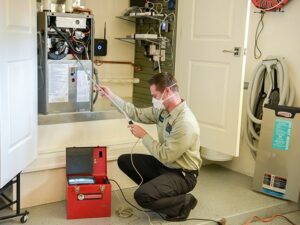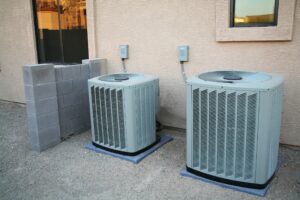Although December temperatures in Bakersfield, CA, typically only dip into the 40s, having a safe, well-maintained heater to keep your home warm is essential. Many homeowners have a gas furnace thanks to the lower operating cost and higher energy efficiency. However, there are a few potentially hazardous heater problems you shouldn’t ignore. The experts at Monarch Home Services have more information about heater issues that can seem insignificant at first but could become more severe if they’re neglected or your heater doesn’t get the maintenance it needs.

Cracked Heat Exchanger
Gas, including dangerous carbon monoxide, is a byproduct your furnace creates during the heating process. However, your furnace’s heat exchanger is designed to keep the fumes secure and out of your home by transferring the heat produced in the combustion chamber to the indoor air while keeping each “side” separate. If your heat exchanger is cracked, it can lead to a hazardous gas leak. Cracked heat exchanger symptoms include soot buildup around the furnace, odd smells, or even flu-like symptoms among members of your household.
Heat exchangers are made of metal, so they expand and contract as they heat up and cool down. This means they’re vulnerable to corrosion and other forms of wear and tear, eventually making the component brittle or creating small cracks. Once the heat exchanger is cracked, harmful combustion products like carbon monoxide from the furnace can mix with the air you breathe inside your home. Although smaller concentrations aren’t typically deadly, exposure to carbon monoxide can harm your long-term and short-term health.
Malfunctioning Pilot Light or Ignition System
A malfunctioning pilot light is one of the most common heater issues homeowners face. If your pilot light’s flame is flickering instead of steady, or orange or yellow instead of blue, you should turn off your furnace and call Monarch immediately. These red flags signal a problem with gas flow, the thermocouple, or the pilot light itself and can pose a safety risk. Check your pilot light occasionally to confirm it’s working correctly.
A loud bang from your furnace when it turns on could be due to delayed ignition. When it works correctly, your furnace supplies gas to the burners, which light up immediately. If something prevents the burners from lighting, gas builds up inside your furnace and creates the bang you hear, which is a small explosion. If you suspect that your furnace has delayed ignition, contact the skilled team at Monarch Home Services right away for an inspection and reliable heater repair near you.
Poor Ventilation and Carbon Monoxide Leaks
Carbon monoxide is an odorless, colorless gas that often goes undetected until it’s too late. One of the most dangerous heating system problems is when the furnace has inadequate or blocked ventilation. Without proper ventilation, the carbon monoxide gas will escape and enter your home, where you breathe it in unknowingly.
Poorly vented appliances and furnaces trap gas and force it back inside your home. Make sure your furnace and other gas-powered items have safe, secure, and adequate ventilation. Install carbon monoxide detectors to alert you of a leak, and schedule routine maintenance and inspections to verify that everything is operating safely.
Additional Hazardous Heater Problems You Shouldn’t Ignore
Other signs you shouldn’t ignore that could indicate you have a hazardous heater problem are:
- Malfunctioning flame sensor or thermocouple: These two safety devices shut off the gas supply to prevent buildup, but if they’re faulty, excess gas buildup inside your furnace can cause the gas to leak inside your home.
- Unusual noises: Banging, screeching, or rattling sounds indicate loose or worn components or an issue with the blower that requires urgent attention.
- Odd odors: The smell of rotten eggs is a common sign that you have a possible gas leak, so don’t ignore this hazardous heater problem.
- Heater won’t turn off: If your furnace doesn’t shut off intermittently, it can lead to the system overheating, which might result in a costly breakdown.
How To Tell If Your Heater Needs Professional Repair
Remember these signs that your heater needs repair, and contact us immediately if you experience any of them:
- Loud noises or unpleasant odors: Unusual, loud sounds or unpleasant odors from your heater are common signs that your system needs professional repair.
- Water leaks: Standing water or visible leaks anywhere near your heater mean it needs professional attention as soon as possible.
- High energy bills: If your monthly energy bill suddenly skyrockets, it likely means your heater is malfunctioning and needs urgent repair.
- Insufficient or uneven heating: If your heater isn’t heating your home evenly or not heating it enough, contact the experts at Monarch to schedule a professional diagnosis and repair.
- Short-cycling: If your heater turns on and off frequently, there could be a problem with the thermostat or other components, which can raise your energy bills significantly.

Preventing Heater Hazards with Routine Maintenance
Fortunately, routine maintenance should help you prevent the most common heater hazards. Keep these helpful furnace maintenance tips and heater safety tips in mind for a comfortable, safe home:
- Visually inspect your heater every few days for pilot light issues, and schedule a professional inspection annually so an experienced HVAC technician can catch minor issues early before they become serious problems.
- Inspect and change your furnace air filter regularly, according to the manufacturer’s instructions, to maximize airflow and maintain adequate ventilation.
- Keep the area around your furnace free of obstructions to prevent a fire hazard.
- Schedule an annual furnace inspection, cleaning, and tune-up in the fall before the cold winter temperatures arrive.
- When you schedule a furnace inspection, change the batteries in your home’s carbon monoxide detectors so they’re in good working order.
- Have a professional test your furnace’s thermocouple or flame sensor to confirm it works properly.
- Keep the furnace blower and burner clean and debris-free to prevent excess soot and dust buildup that might cause heater safety and efficiency issues.
When To Call for Emergency HVAC Help
If you ignore a heating system issue, it can lead to expensive repairs later or may even pose a safety risk due to a gas leak. Here’s when to call us for HVAC emergency repair.
- You notice a strong gas odor or a “rotten egg” smell in your home.
- Loud hissing noises are coming from your heater, which could indicate a cracked heat exchanger or a potential gas leak.
- There is pooling water or leaks anywhere near your furnace, or you notice visible signs of rust and corrosion.
- If your system won’t turn on, contact Monarch for emergency help immediately.
Contact Monarch Home Services Today
The experts at Monarch Home Services provide high-quality, reliable heater services throughout Bakersfield, Fresno, Visalia, and beyond. We’re here to help make your home as safe and energy-efficient as possible in every season. If you’d like to learn more or schedule a professional HVAC system or furnace service, contact us today!


